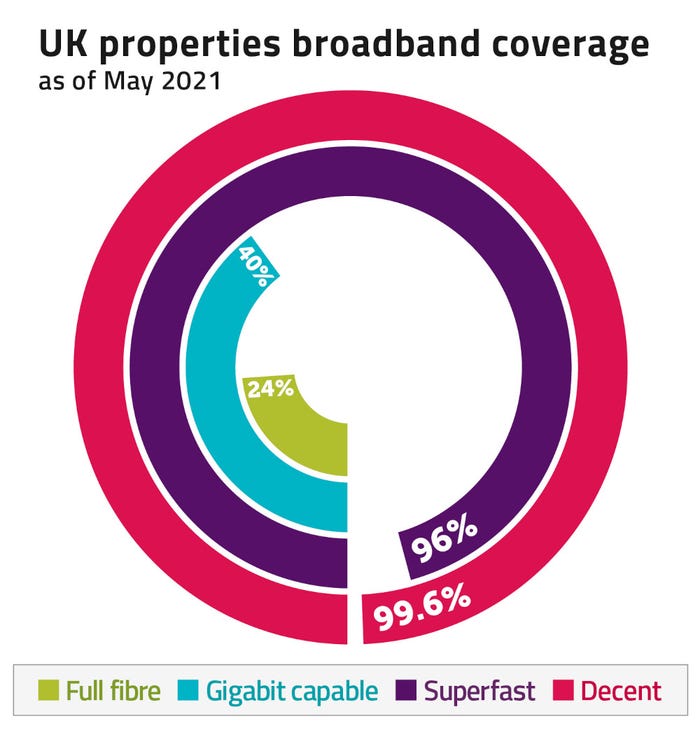Almost a quarter of UK households now have access to full fibre broadband and Ofcom is pretty excited about that.
September 9, 2021

Almost a quarter of UK households now have access to full fibre broadband and Ofcom is pretty excited about that.
The UK telecoms regulator’s latest ‘Connected Nations’ update puts full fibre coverage at 24%, with 6.9 million homes passed, as of May 2021. That’s an increase of three percentage points and 1 million homes since January, which is a creditable growth rate, but perhaps not as stellar as Ofcom’s announcement suggests.
“Around one in four UK homes can now get faster full-fibre Internet, as broadband companies have extended their networks at rapid pace during the pandemic,” the regulator declared in a statement accompanying its new data. The announcement bears the title ‘Broadband networks rush to meet UK’s need for speed,’ incidentally.

There is no doubt that the Covid-19 pandemic and associated need for home working and a greater level of home entertainment has driven the development of fibre broadband in the UK. Ofcom did not share take-up rates for full fibre, but noted that as of March this year 85% of home broadband lines get north of 30 Mbps or higher – that’s the advertised speed, at least – up from 75% in November 2019 before the pandemic took hold. 5% of connections were in the 300 Mbps-plus bracket.
But that 24% full fibre coverage figure means the UK is still some way behind many of its European peers.
The most recent figures from IDATE for the FTTH Council Europe, which admittedly are a year old now but an update is due next week, put the average fibre-to-the-home/building (FTTH/B) coverage rate at 43.8% in the 27 EU markets plus the UK, as of September 2020. At that date, the UK ranked third bottom of those 28 countries with a penetration rate of just over 15% and only six countries had covered fewer homes, percentage-wise, than the UK’s current rate based on Ofcom data.
Doubtless there are differences between the two sets of data, but pulling them together serves to demonstrate that while Ofcom is whooping and hollering about fibre penetration growth, there is still a long way to go.
That said, there are plenty of companies pushing the fibre market forward in the UK.
According to Ofcom, the January-May growth was predominantly driven by the larger fibre infrastructure providers, but support – or competition, if you prefer – is coming from an increasing number of smaller outfits.
Indeed, this summer saw the continued expansion of UK fibre builders at the small-scale end of the market. Kent-based Trooli brought in new funding, Hyperoptic has announced a number of deals with councils and home builders, and Lightspeed Broadband announced a deal with Nokia to help it expand its network in eastern England, to name but three. Meanwhile, Openreach and BT moved to cut the cost of FTTP and Virgin Media O2 shared full fibre network upgrade plans.
Thus it seems that while Ofcom’s excitement over a 24% coverage rate might be a little over-egged, its optimism is not misplaced.
Unless you’re among the 134,000 premises that still cannot access what Ofcom terms a ‘decent’ connection, or a 10 Mbps download/1 Mbps upload service; the ability to stream TV and make video calls, basically. The regulator notes that these premises could be eligible for an upgrade under broadband universal service guidelines. Well, that’s alright then.
Get the latest news straight to your inbox. Register for the newsletter now
About the Author(s)
You May Also Like








.png?width=300&auto=webp&quality=80&disable=upscale)


_1.jpg?width=300&auto=webp&quality=80&disable=upscale)


.png?width=800&auto=webp&quality=80&disable=upscale)